Table of Contents
Mass tree
Description
In the left part of the dialog - below the symbols - the objects you have derived appear in the mass tree. Before you create data, only the group is in the tree All (yellow folder icon). Further groups can be created by the processor. You can use any number of hierarchies here. Once created, mass trees can be saved and later imported into new drawings. The objects that you derive from the drawing are then sorted below the groups.
Groups are the main structure objects in the mass tree. Groups can be used to create mass tree structures so that the individual objects can be stored clearly. Groups can be transferred to subordinate groups and objects with properties.
Im Object manager you can manage and organize (create, delete, etc.) groups in different ways (menu, keyboard, mouse), e.g. by touching and moving them (with the left mouse button pressed, known as the drag & drop function from Windows Explorer ). You will find a detailed description of the editing options in the following chapter.
The function for creating a new group can be accessed via menu Mass> New> Groups / Collectors ... or with the right mouse button New> Groups / Collection Objects be called.
Features
The following symbols are used in the mass tree:
| Group | |
| Group activated | |
| Group with assigned plants | |
| Group with assigned materials | |
| Group with assigned material and plant properties | |
| he grunted-Group | |
| indirectly coupled group | |
| Hierarchy object with direct coupling | |
| Position object | |
| Object ⁄ contour object | |
| Object with assigned material property | |
| Object with its own graphic property | |
| Object with deduction areas | |
| Object with assigned material properties and deduction area | |
| Object with deduction area and its own graphic property | |
| Object with assigned plants | |
| Object with assigned material and plant properties | |
| Object with assigned material, plant properties and deduction areas | |
| Single plant | |
| Single plant with assigned material properties | |
| Individual objects with material | |
| Material items in the specification of services (item coupling) | |
| 3D object | |
| 3D object with assigned material property | |
| 3D object with its own graphic property | |
| 3D object with deduction area | |
| 3D object with assigned material property and deduction area | |
| 3D object with assigned graphic property and deduction area | |
| 3D object with assigned plant | |
| 3D object with assigned material and plant properties | |
| 3D object with assigned material, plant properties and extraction area | |
| intersection | |
| connected database | |
| record |
The editing options correspond roughly to those known from other Windows applications and can be used on groups and objects. Multiple selection is also possible (mouse click while holding down CtrlButton) possible.
The Windows clipboard is not used as temporary memory, but an internal memory in the program. This means that im Object manager cut objects cannot be pasted in other programs. Exiting the object manager empties the internal memory. If there are still objects in the internal memory that have not yet been inserted, you will receive a message and the option to insert them.
If groups are edited, the functions always relate to the content. If you delete a group, for example, all objects contained in it are also deleted.
The following commands only take into account the objects that are activated in the mass tree, regardless of whether you click on the objects marked something or not.
cut out
The cut function  can be via the menu Edit> Cut or over Mark object> right mouse button> cut be called.
can be via the menu Edit> Cut or over Mark object> right mouse button> cut be called.
Cuts objects or mass tree structures from the Object managerwhich then with Insert (see Chapter Insert) can be inserted back into the mass tree. In the configuration you can specify that only group structures without individual objects should be cut out.
Copy
The copy function  can be via the menu Edit> Copy or over Mark object> right mouse button> copy be called.
can be via the menu Edit> Copy or over Mark object> right mouse button> copy be called.
Copies objects or mass trees from the Object managerwhich then with Insert (see Chapter Insert) can be inserted back into the mass tree. In the configuration you can specify that only group structures without individual objects are to be copied.
Insert
The Insert function  can be via the menu Edit> Paste or over Mark object> right mouse button> insert be called.
can be via the menu Edit> Paste or over Mark object> right mouse button> insert be called.
Objects or mass tree structures that have previously been cut or copied are inserted. A multiple insertion is possible.
Delete
The delete function  can be via the menu Edit> Delete or over Mark object> right mouse button> delete be called.
can be via the menu Edit> Delete or over Mark object> right mouse button> delete be called.
From the Object manager deleted objects are not removed from the drawing. For contour lines (see Contours) this can optionally be switched on in the configuration (see Options). On the other hand, when deleting drawing objects that are in Object manager are recorded, they are also removed from the mass tree at the same time. A notice appears for this.
Move
The move function can be accessed via Mark object> press left mouse button> move object to new position be called.
When groups are moved, the objects they contain are also moved. The option Copy and cut without objects (please refer Options) has no influence on this function. You can also click on the Objects tab Mark one or more objects or groups and move them to a new position with the left mouse button pressed.
Administer
Mass trees created in Object manager you can either as a pure mass tree structure or as a mass tree with objects in a directory or in a library in the Quick manager export. This enables you to import and use the exported mass trees quickly and easily in other drawings or on other computers. All properties defined in the tabs (e.g. Schedule and Label) saved with. With the help of this functionality, the work becomes very effective, since standards can be defined and there is no need to re-create mass trees. A thematic mass tree structure or a mass tree structure adapted for different output scales is useful.
Import bulk tree only
The function Import bulk tree only can be via the menu Mass> import structure ... or over Mark group> press right mouse button> import structure ... be called.
Application
- In the left window, mark the point where the mass tree should be inserted.
- Call the function via the menu or the right mouse button Import structure ... .
- Select the file to import.
- The mass tree is inserted below the marking.
Export bulk tree only
The function Export bulk tree only can be via the menu Mass> Export structure ... or over Mark group> press right mouse button> export structure ... be called.
Application
- In the left window, mark the point from which the mass tree should be exported.
- Call the function via the menu or the right mouse button Export structure ... .
- The mass tree is exported with Save.
Import mass tree with objects
The function Import mass tree with objects can be via the menu Bulk> Extended Import ... or over Mark the group> press the right mouse button> Extended import ... be called.
Application
- In the left window, mark the point from which the mass tree should be inserted.
- Call the function via the menu or the right mouse button Extended import ... .
- Select the file to import.
- Specify the insertion point for the objects. Will this with the EnterButton, the objects are inserted as in the original.
- The mass tree is inserted below the marking.
Note that importing very large mass trees can take a long time. Therefore, check the use of the option in advance Do not sort graphics order under Options> General tab.
Export mass tree with objects
The function Export mass tree with objects can be via the menu Bulk> Extended Export ... or over Mark the group> press the right mouse button> Extended export ... be called.
Application
- In the left window, mark the point from which the mass tree should be exported.
- Call the function via the menu or the right mouse button Extended export ... .
- In the dialog you can make various settings for the export. The individual setting options are explained below.
- With [OK] the mass tree is exported.
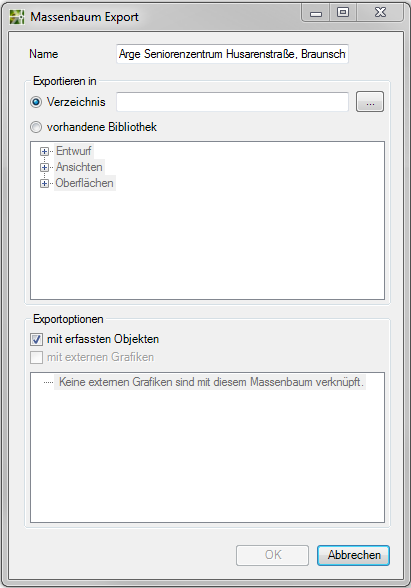
Settings for export
| Name | The name is automatically assigned based on the group in the mass tree. You can also enter a name manually. |
| Export to | Directory: Enter a directory into which the mass tree is to be exported. To do this, click the button [...]. |
| Export to | existing library: Select im Quick manager Under Design, View or Surfaces the desired storage location to which the mass tree is to be exported. Will the mass trees in the Quick manager then you can simply drag and drop them into other drawings. |
| Export options | Choose whether in the mass tree detected objects and used external graphics (e.g. own symbol lines or blocks) should be exported as well. The external graphics used in the mass tree are sorted according to their type and listed in the lower window. |
Store the export files in a central location so that all editors can use them.
Examples of mass trees
In order to show the universal usability of the object manager, the scope of delivery of the object manager contains mass trees from the subject areas of the plan sign regulation and cost estimate DIN 276.
Mass tree plan sign
This mass tree contains many symbols, hatching and symbol lines from PlanzV 90. By assigning objects or contours in the Object Manager, documents for site planning can be created very easily. This mass tree is very suitable for the implementation of simple and smaller planning projects.
To use the mass tree, go over in the menu Bulk> Import and select the file Plan Sign Ordinance 1990.mbd from in the folder plantv in the user directory of DATAflor CAD is located.
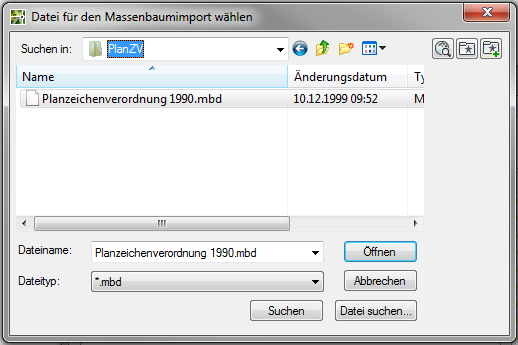
In the second step, the drawing objects are recorded and stored in the relevant groups.
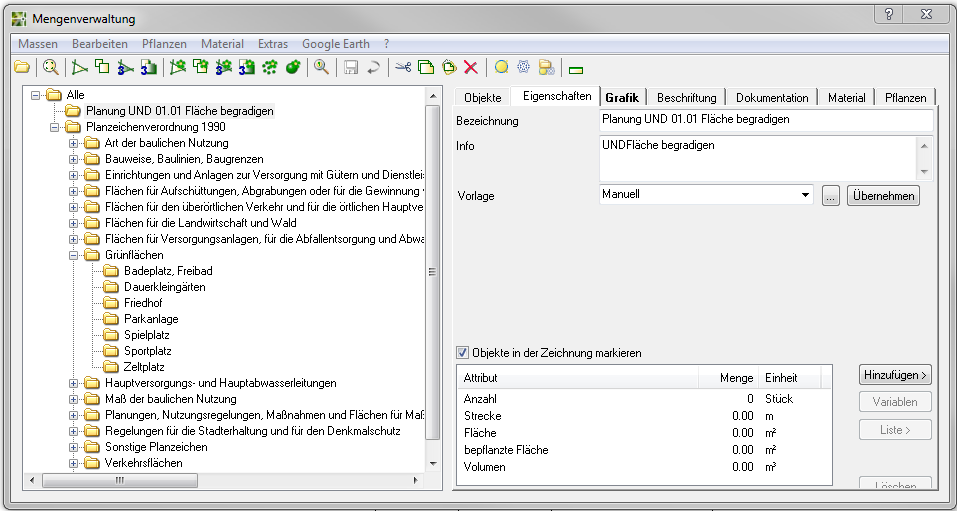
The groups were assigned the appropriate hatching, symbol lines and symbols by default. As soon as the objects are pushed into the groups, the object takes on the defined property.
The hatching, symbol lines and symbols are used when installing DATAflor CAD in the directory plantv in the user directory of DATAflor CAD filed.
Mass trees cost estimate DIN 276
With these mass trees you can very quickly create a cost and area compilation of the current planning according to DIN 276, without the more complex transfer to a tendering program. There are four different mass trees available to you:
- Cost groups DIN 276 - April 1981 edition.mbd
- Cost groups DIN 276 - June 1993 edition.mbd
- Cost groups DIN 276 - November 2006 edition.mdb
- Cost groups DIN 276 extension for landscaping - June 1993 edition.mbd
To use one of the mass trees, go over in the menu Bulk> Import and select one of the four files in the folder din276 in the user directory of DATAflor CAD are located.
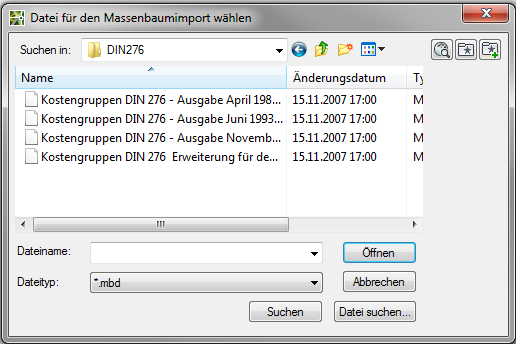
In the second step, the drawing objects are recorded and stored in the relevant groups. Via the menu Mass> to Excel you will receive the compilation.
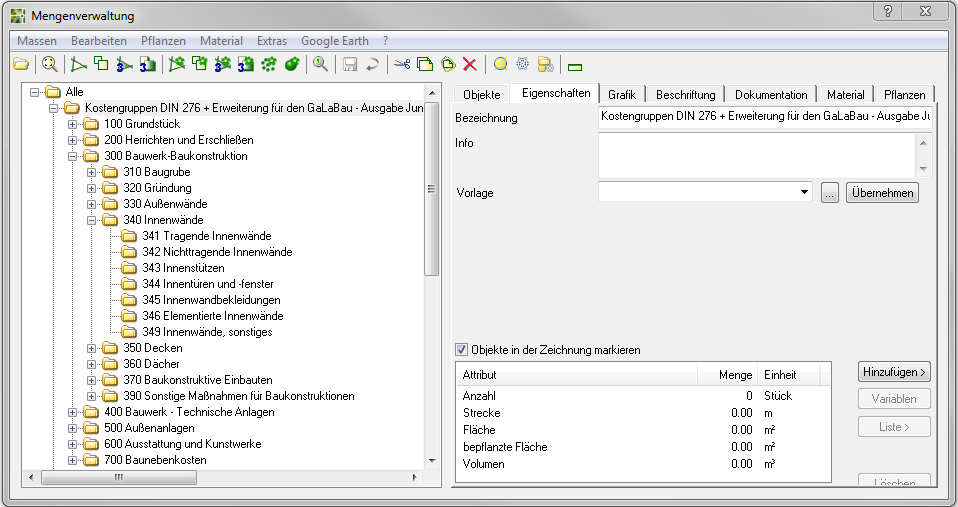
Depending on how you opened the tree, you will receive a summary or the details of the cost and area composition.
If you are in the Features Define formulas (e.g. area x price per square meter), you will also receive a price overview.
